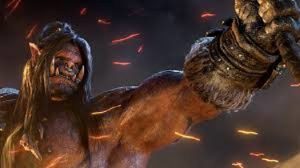Other worldly Warcraft (2016) is that kind of movie. It’s hard to keep up with all the names of characters. Who’s who, in other words.
It’s a long time ago when I knew, almost inside out, who actually populated Star Wars though my mother didn’t have a clue. Now, I’m older and any teenage fan would know a lot more than I do about the Warcraft world. But does it matter?
I’ll write about what I do know. That’s easier.
Warcraft seems to be more than an indecipherable word count of names. Perhaps it is deep, thematically speaking.
Orcs and humans live in parallel or literally different worlds. There is empathy for both orcs and humans. Well, that is how I felt about it.
A chieftain orc is a likeable brute.
In one scene, this chief is in bed with his wife (are they called wives?) who is pregnant. They exchange a few medieval pleasantries and we the audience may like this couple.
I especially liked the chief. Despite fangs and bulky stature, he is still quite human-like with a sense of humor and even a hint of vulnerability.
The orcs seem to be from a world of struggles. Why wouldn’t we identity with them?
The orcs need a home; the orcs have to get rid of the humans because they need to make a home in the human world. But the humans will protect their home the orcs are attacking.
It would be natural to identity with humans as we are human. Though there are things we like and dislike about our own.
I think the thrust of coming on the side of the humans is that they are living in peace but are being attacked by the orcs.
Like someone lives in peace and finds their home raided; it’s natural to side with someone in that predicament.
We the audience may have empathy for them both; the humans and orcs both have interests in the comforts of home. Couldn’t they sort-of share a home? Perhaps not in Warcraft.


